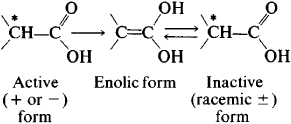Racemization
Also found in: Dictionary, Medical, Wikipedia.
racemization
[‚rā·sə·mə′zā·shən] (organic chemistry)
A process by which an optically active form of a substance is converted into a racemic mixture.
McGraw-Hill Dictionary of Scientific & Technical Terms, 6E, Copyright © 2003 by The McGraw-Hill Companies, Inc.
The following article is from The Great Soviet Encyclopedia (1979). It might be outdated or ideologically biased.
Racemization
the formation of an optically inactive product (racemate) as a result of a reaction involving an asymmetric atom. Racemization is caused by the appearance of an intermediate compound (or transition state), not itself possessing an asymmetric atom, which has an equal probability of yielding optical antipodes. The antipodes, in turn, form racemic compounds. The racemization of carboxylic acids, for example, involves enolization:

Racemization occurs in reactions leading to the formation of the flat carbonium ion and in reactions that are carried out through free radicals.
The Great Soviet Encyclopedia, 3rd Edition (1970-1979). © 2010 The Gale Group, Inc. All rights reserved.